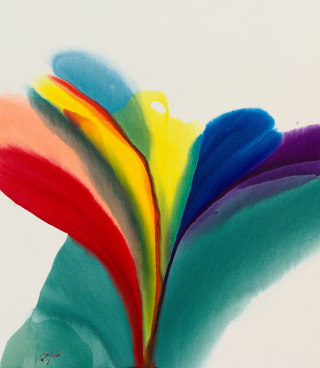Timothy Taylor Welcomes Paul Jenkins
Timothy Taylor is pleased to announce that it is now working with The Paul and Suzanne Jenkins Foundation. A historical painting by Jenkins will be included in the gallery’s presentation at Art Basel Miami in December, and Timothy Taylor will mount a solo exhibition of the artist’s work from the 1950s to 1970s at the gallery’s New York location in 2025. Timothy Taylor will work closely with The Paul and Suzanne Jenkins Foundation in collaboration with Ronchini Gallery in London.
Jenkins (1923–2012) is an American artist celebrated for his luminous, jewel-toned abstract paintings that appear to extend outwards beyond the edges of their canvases. His work is characterised by its sense of energy, which the artist achieved through multiple gestural pours of pigments on his canvas supports as they lay flat on the studio floor, working wet on wet and coaxing interactions between differing viscosities of paint. The resulting pieces are at once strident and enigmatic, calligraphic and marked by chance. Of the significance of his work, Jenkins stated, “If I make a contribution, it’s painting something that is there but cannot be seen except through the experience of painting.”
Born in Kansas City, Missouri in 1923, Jenkins was drawn to art from childhood. He came of age at the onset of World War II and served in the U.S. Naval Air Corps. Jenkins subsequently travelled to New York on the G.I. Bill, where he studied at the Art Students League under master printmaker and painter Yasuo Kuniyoshi before departing for Europe in 1953, travelling throughout Italy and Spain and finally settling in Paris. In Paris he developed the method that would come to define his practice: applying paint through a series of pours during which he manually manipulated his canvas, a highly expressive process that drew comparisons to the physically demanding mark-making of his Action Painter friend and artistic peer Jackson Pollock. However, while Jenkins forged close ties with many prominent Abstract Expressionists within his New York circle including Barnett Newman, Mark Rothko, and Joan Mitchell, his work was informed by influences far beyond the city’s limits, including Zen Buddhism and the art of Western Europe. As the art historian Beatrice Buscaroli notes, “His decision to come to Europe, and his deliberate choice of History, Italy, Michelangelo, the Pompeian frescoes, Pisanello and Carpaccio enriched the structure of his work beyond the elementary power of the Abstract Expressionists.”
In the late 1950s and early 1960s Jenkins made the gradual transition from oil to acrylic; the latter could be thinned to translucent sheets and transparent, veil-like skeins of colour without the use of turpentine (which had the undesired side-effect of muting some of the pigments’s intensity). Rather than using unprimed canvases into which pigment would seep, staining their fibres, he worked on primed canvases whose smooth surfaces allowed paint to glide, guided by the swooping motions of his hand. In 1958, he was gifted what became an essential tool in his practice—the ivory knife—which helped shape the flow of paint poured in his works. During this time he began to preface each of his titles with the word “Phenomena,” followed by a poetic description of the work’s properties and effect; hereafter Jenkins would refer to himself as an “Abstract Phenomenist.” Poetry was an abiding passion for the artist and infused all facets of his life and practice.
Throughout his oeuvre, Jenkins tested the spiritual limits of abstraction, exploring paint’s capacity to capture the transcendent on earthly grounds.
We are honoured to begin working with The Paul and Suzanne Jenkins Foundation—Jenkins is an artist I have admired for decades. I am particularly excited for new audiences to discover how his poetic and spiritual work fits within the history of mid-century American painting, and I very much look forward to developing exhibitions with the Foundation. —Timothy Taylor, Founder

